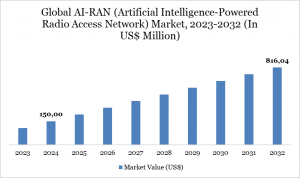Artificial Intelligence-Powered Radio Access Network (AI-RAN) Industry Set to Reach $816,04M, with CAGR of 23.75%
AI-RAN (Artificial Intelligence-Powered Radio Access Network) Industry Insights 2025-2032: Market to Hit $816M, Rapid Growth at 23.75% CAGR Predicted
AI-RAN Market in the USA reached $150,00M in 2024 and is set to hit $816,04M by 2032, growing at a CAGR of 23.75% through 2032.”
WILMINGTON, DE, UNITED STATES, October 6, 2025 /EINPresswire.com/ -- Artificial Intelligence-Powered Radio Access Network Market Overview— DataM Intelligence 4Market Research LLP
The AI-RAN (Artificial Intelligence-Powered Radio Access Network) Market was valued at US$ 150,00 million in 2024 and is projected to climb to US$ 816,04 million by 2032, registering a compound annual growth rate (CAGR) of 23.75% from 2025 to 2032.
As mobile data traffic continues to soar, traditional RAN architectures face scalability and energy challenges. AI integration in RAN enables real-time decision-making, intelligent load balancing, and proactive fault detection, reshaping how networks are deployed and managed globally.
Get a Sample PDF Of This Report (Get Higher Priority for Corporate Email ID):– https://www.datamintelligence.com/download-sample/artificial-intelligence-powered-radio-access-network-market
Market Dynamics
Growing Need for Intelligent Network Automation
The surge in data consumption, combined with the rollout of 5G and edge computing, has accelerated the demand for self-optimizing networks (SONs). AI-powered RAN solutions use machine learning algorithms to monitor traffic patterns, predict network congestion, and automatically adjust parameters. This results in reduced operational costs, higher network efficiency, and improved user experience.
Telecom giants such as Ericsson, Nokia, and Huawei are leveraging AI to develop intelligent base stations capable of real-time analytics and predictive maintenance. DataM Intelligence’s analysis indicates that automation in RAN could reduce energy consumption by nearly 20–25%, aligning with global sustainability goals.
5G Deployment Driving AI-RAN Adoption
The transition from 4G to 5G has introduced network complexities requiring adaptive and self-learning systems. AI enhances 5G RAN by dynamically allocating spectrum, reducing latency, and managing dense urban network traffic. AI models embedded in baseband units and distributed units enable predictive radio resource management, minimizing downtime and enhancing spectral efficiency.
Countries such as the United States, Japan, South Korea, and Germany are leading early adopters of AI-RAN technologies. Telecom operators in these regions are investing in AI-based Open RAN (O-RAN) solutions to achieve vendor interoperability and cost flexibility.
Energy Efficiency and Green Networking
Energy consumption in radio networks accounts for over 60% of total mobile operator energy use. Integrating AI helps optimize network parameters like sleep modes, antenna tilt, and power allocation, reducing carbon footprints while maintaining performance. AI-RAN also supports sustainability by enabling energy-aware traffic scheduling, an increasingly critical factor for green telecom operations.
DataM Intelligence highlights that leading network providers are collaborating with cloud and AI firms to build energy-optimized 5G infrastructures—one of the key growth accelerators in the forecast period.
Challenges and Limitations
Despite its potential, the AI-RAN market faces challenges such as data privacy concerns, interoperability issues, and high implementation costs. Integrating AI models into existing RAN infrastructure requires extensive data training, robust cybersecurity frameworks, and advanced computational hardware.
Moreover, the lack of standardization in AI algorithms across vendors has created fragmentation in deployment strategies. Overcoming these barriers through collaborative AI model training and federated learning frameworks remains a key opportunity for market participants.
Segmentation Analysis
By Component
1. Software: Includes AI platforms for predictive analytics, traffic management, and automation.
2. Hardware: Encompasses AI accelerators, edge processors, and baseband units integrated with AI chips.
3. Services: Managed services, AI training, and system integration play vital roles in market expansion.
By Technology
1. 4G LTE RAN
2. 5G RAN
3. Open RAN (O-RAN)
4. The 5G RAN segment dominates due to the growing deployment of smart antennas and AI-driven radio resource management.
By Application
1. Network Optimization
2. Energy Management
3. Predictive Maintenance
4. Dynamic Spectrum Allocation
5. AI-based network optimization currently holds the largest market share, offering operators real-time insights and enhanced customer experience.
Buy Now & Unlock 360° Market Intelligence:- https://www.datamintelligence.com/buy-now-page?report=artificial-intelligence-powered-radio-access-network-market
Regional Analysis
North America
North America leads the global market, particularly the United States and Canada, due to early 5G adoption and strong AI R&D ecosystems. Companies are investing in AI-based RAN to reduce energy costs and improve network intelligence across dense urban regions.
Europe
Europe’s AI-RAN growth is driven by initiatives promoting Open RAN adoption and vendor-neutral ecosystems. The UK, Germany, and France are spearheading trials for AI-integrated 5G networks to enhance digital connectivity across industries.
Asia-Pacific
The Asia-Pacific region, especially China, Japan, and South Korea, is witnessing massive investments in AI-powered telecom infrastructure. Japan’s telecom operators are focusing on AI-based small cell optimization to handle increasing IoT device density.
Competitive Landscape
1. NVIDIA
2. NOKIA
3. Mavenir
4. SAMSUNG
5. NEC Corporation
6. FUJITSU
7. ZTE Corporation
8. VIAVI SOLUTIONS INC.
9. Radisys
10. Telefonaktiebolaget LM Ericsson
Get Customization in the report as per your requirements:- https://www.datamintelligence.com/customize/artificial-intelligence-powered-radio-access-network-market
DataM Intelligence’s report notes that strategic collaborations, AI cloud integrations, and federated learning-based model training are shaping the future of competitive advantage in this sector.
Future Outlook and DataM Intelligence Insights
According to DataM Intelligence, the global AI-RAN market is poised for strong growth through 2032, supported by the convergence of AI, edge computing, and next-generation communication technologies.
To stay competitive, telecom operators should:
Adopt AI-driven automation platforms to improve operational efficiency.
Invest in green AI models for sustainable network operation.
Collaborate with AI and cloud technology providers to enhance model accuracy and scalability.
As 6G development begins, the integration of AI-native RAN architectures will play a defining role in achieving self-evolving, intelligent wireless networks.
Related Reports
Telecom Infrastructure Market
Cloud-based Printing Market
Sai Kiran
DataM Intelligence 4Market Research LLP
+1 877-441-4866
sai.k@datamintelligence.com
Visit us on social media:
LinkedIn
X
Legal Disclaimer:
EIN Presswire provides this news content "as is" without warranty of any kind. We do not accept any responsibility or liability for the accuracy, content, images, videos, licenses, completeness, legality, or reliability of the information contained in this article. If you have any complaints or copyright issues related to this article, kindly contact the author above.


